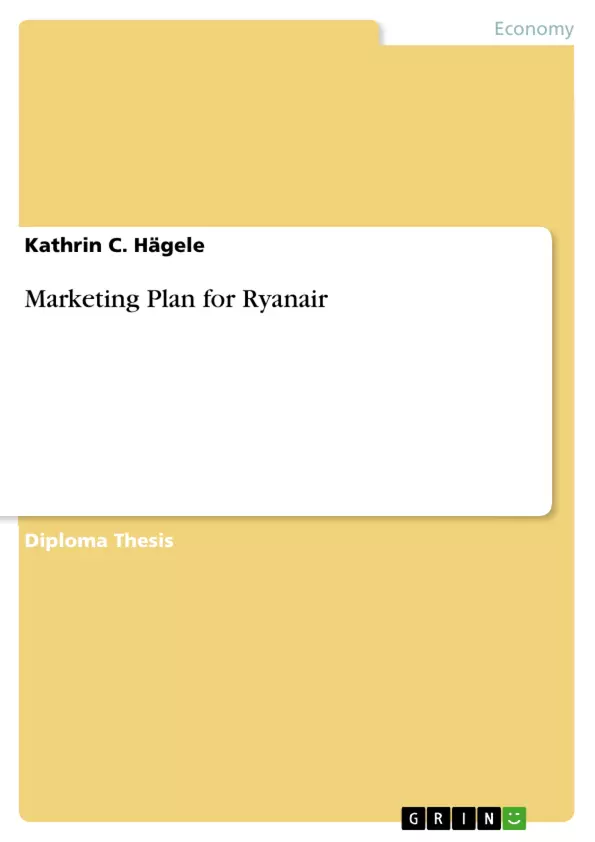This study looks at external and internal key influences of the environment of the Ryanair Company.
This is as a first step important to come up with strategies, which Ryanair could take to stay as
successful as they are right now.
The first chapter starts with an analysis (PESTEL) of the external environment (macro-environmental),
which includes all the external factors such as economic, political, legal, technological, ecological and sociocultural, that can exert direct and indirect pressure on both domestic and international marketing
activities. The second chapter goes on with a critical evaluation of the firm’s current and anticipated
internal environment (micro-environmental) with respect to its objectives and performance, allocation of
resources, structural characteristics, and political power. Therefore the SWOT Analysis is used as well
as the Value Chain Analysis. The last point in this part is the identification of core competencies of
Ryanair. Furthermore the Porter’s Five Forces Method is used for identifying the market structure in
which Ryanair is operating. The Competitor Analysis follows this. Finally, the last section gives a brief
summary with important concluding remarks.
What has to be stated is that in the following 15 pages just a rough overview of the main points of this
assignment is given. Further details are important to evaluate everything and this is given in the
appendix.
Table of Contents
- 1 Introduction
- 2 Key External Influences
- 3 Key Internal Influences
- 4 Market Structure
- 5 Competitor Analysis
- 6 Development of Strategic Direction
- 7 International Marketing Strategy
- 8 Conclusion
Objectives and Key Themes
This marketing plan aims to analyze Ryanair's success and identify key factors contributing to its position as Europe's largest low-cost airline. The analysis will consider both external and internal influences, ultimately providing a strategic direction for continued success.
- Analysis of Ryanair's external environment (macro-environmental factors).
- Evaluation of Ryanair's internal environment (micro-environmental factors).
- Identification of Ryanair's core competencies and market structure.
- Competitor analysis within the low-cost airline industry.
- Development of a strategic direction for Ryanair's future growth.
Chapter Summaries
1 Introduction: This chapter introduces Ryanair as a remarkable entrepreneurial success story in the European airline industry. It highlights Ryanair's significant growth, its low-fare model, and its extensive route network across Europe. The chapter sets the stage for a deeper analysis of the company's success by outlining the scope of the study which will examine key external and internal influences on Ryanair's operations and strategies for maintaining its competitive advantage.
2 Key External Influences: This chapter employs a PESTEL analysis to examine the macro-environmental factors influencing Ryanair. It explores political, economic, social, technological, ecological, and legal factors affecting the airline industry and their potential impact on Ryanair's operations. The analysis considers the impact of events such as 9/11 and the threat of future terrorist attacks, as well as the potential impact of epidemics like SARS and bird flu on air travel demand and Ryanair's business model which relies on high passenger numbers to maintain low fares. The analysis underscores the importance of understanding and adapting to the changing external environment for maintaining success in the dynamic airline industry.
Keywords
Ryanair, low-cost airline, PESTEL analysis, SWOT analysis, Value Chain Analysis, Porter's Five Forces, competitor analysis, strategic direction, international marketing, European airline industry, growth strategy, low-fare model.
Ryanair Marketing Plan: Frequently Asked Questions
What is the purpose of this document?
This document is a comprehensive language preview of a marketing plan analyzing Ryanair's success. It includes the table of contents, objectives and key themes, chapter summaries, and keywords. The goal is to identify key factors contributing to Ryanair's position as Europe's largest low-cost airline.
What topics are covered in the marketing plan?
The marketing plan covers a range of topics, including an analysis of Ryanair's external environment (macro-environmental factors using PESTEL analysis), its internal environment (micro-environmental factors), core competencies, market structure, competitor analysis within the low-cost airline industry, and the development of a strategic direction for future growth. It also examines Ryanair's international marketing strategy.
What are the key themes explored in the analysis?
Key themes include the impact of external factors (political, economic, social, technological, ecological, and legal) on Ryanair's operations; the evaluation of Ryanair's internal strengths and weaknesses; identifying its competitive advantages; and developing a strategic plan to ensure continued success in a dynamic market.
What methodologies are used in the analysis?
The analysis employs several established frameworks including PESTEL analysis to examine the macro-environment, as well as SWOT analysis, Value Chain Analysis, and Porter's Five Forces to analyze the competitive landscape and internal capabilities. A detailed competitor analysis is also conducted.
What is covered in the introduction chapter?
The introduction chapter presents Ryanair as a significant entrepreneurial success story in the European airline industry, highlighting its substantial growth, low-fare model, and extensive route network. It outlines the scope of the study, which focuses on key external and internal factors influencing Ryanair's operations and strategies for maintaining its competitive advantage.
What is covered in the chapter on key external influences?
This chapter utilizes a PESTEL analysis to explore macro-environmental factors impacting Ryanair, including political, economic, social, technological, ecological, and legal influences. It considers the effects of events such as 9/11, the threat of terrorism, and potential epidemics on air travel demand and Ryanair's business model.
What are the key words associated with this marketing plan?
Key words include: Ryanair, low-cost airline, PESTEL analysis, SWOT analysis, Value Chain Analysis, Porter's Five Forces, competitor analysis, strategic direction, international marketing, European airline industry, growth strategy, and low-fare model.
What is the overall conclusion of the marketing plan (as previewed)?
The preview doesn't explicitly state the overall conclusion, but it aims to provide a strategic direction for Ryanair's continued success based on a thorough analysis of both internal and external factors influencing its operations and competitive landscape.
- Quote paper
- Kathrin C. Hägele (Author), 2006, Marketing Plan for Ryanair, Munich, GRIN Verlag, https://www.grin.com/document/55005



